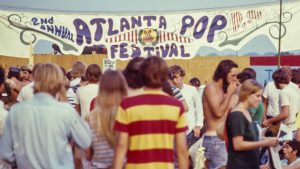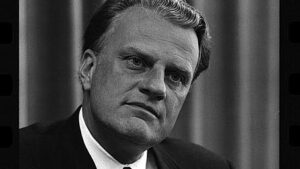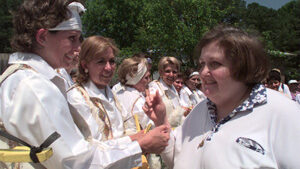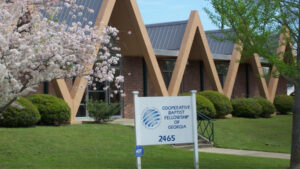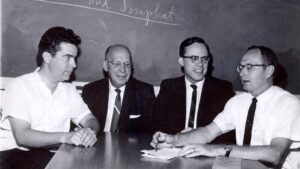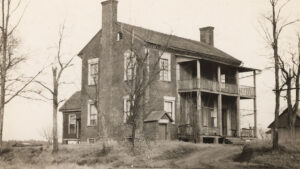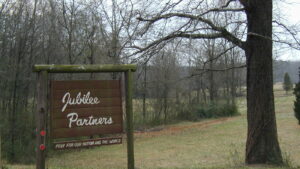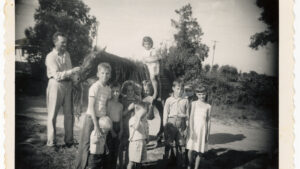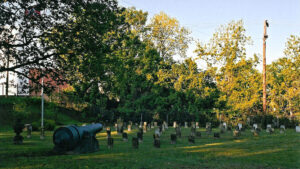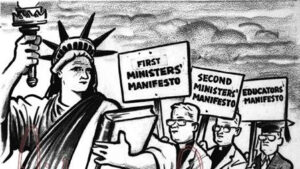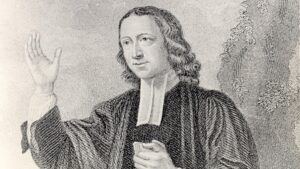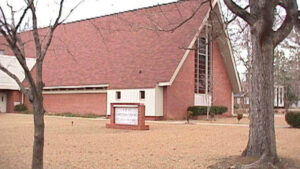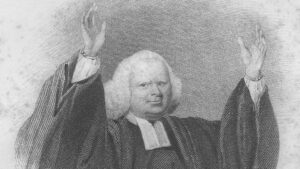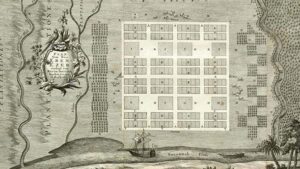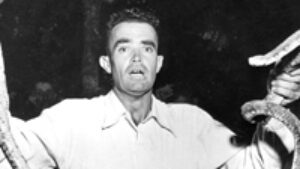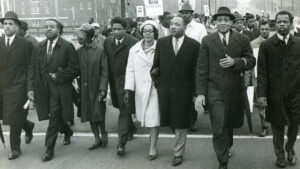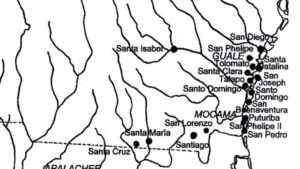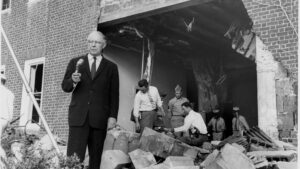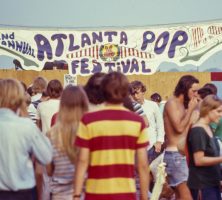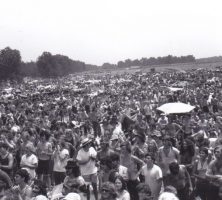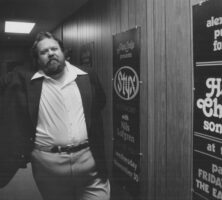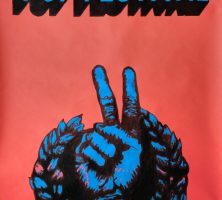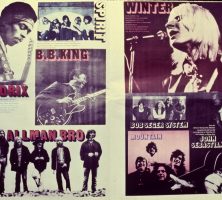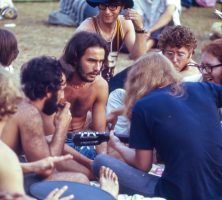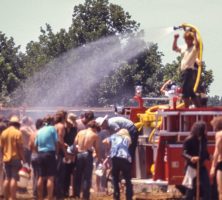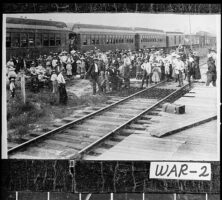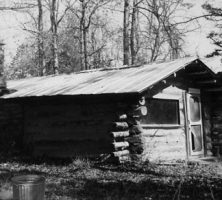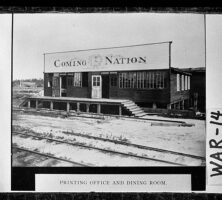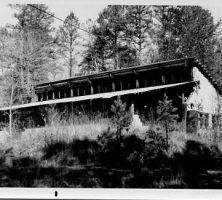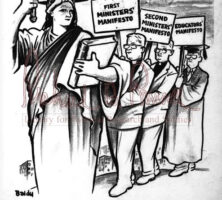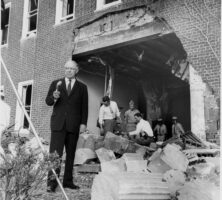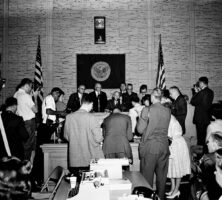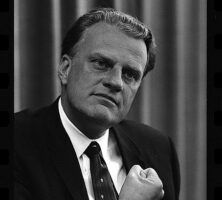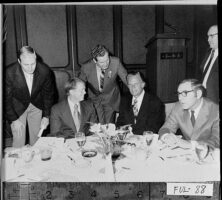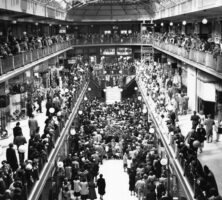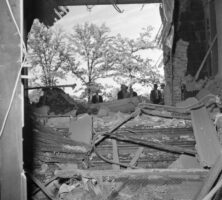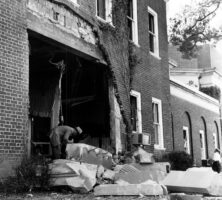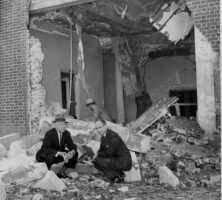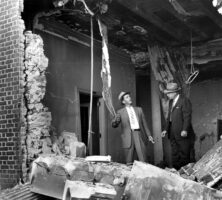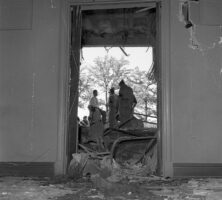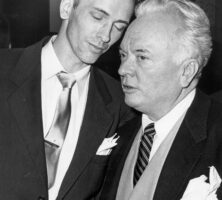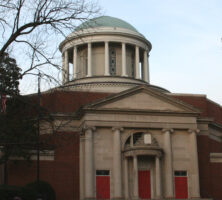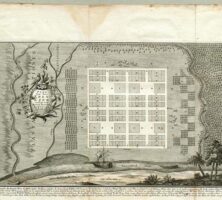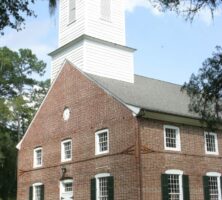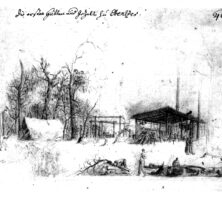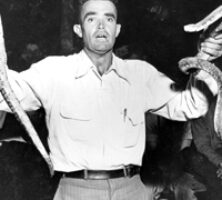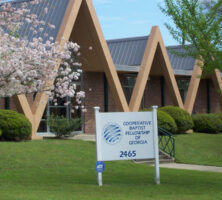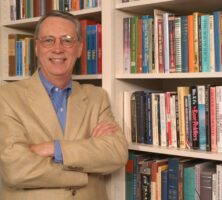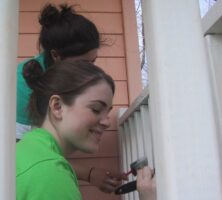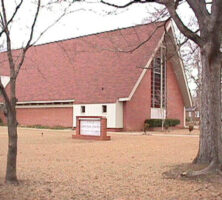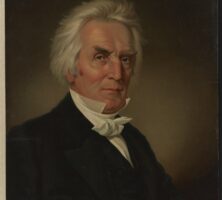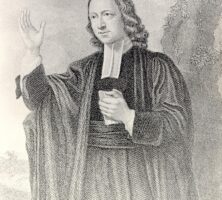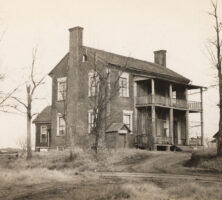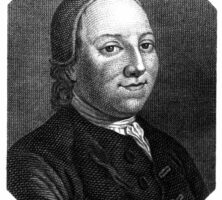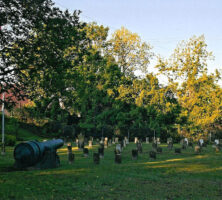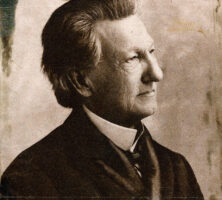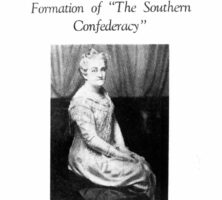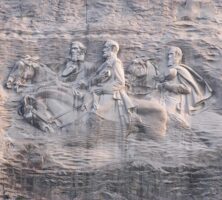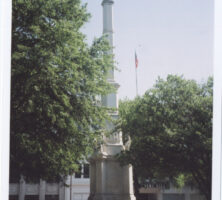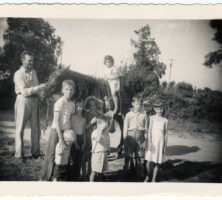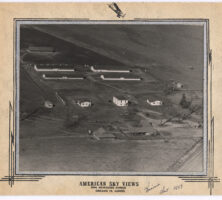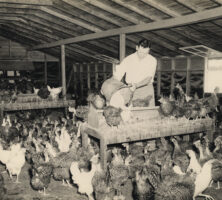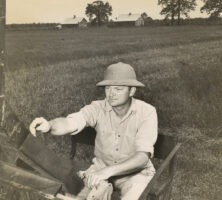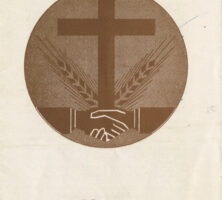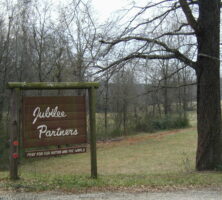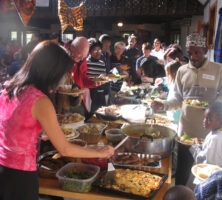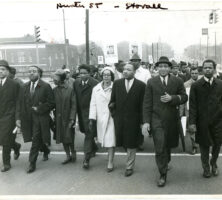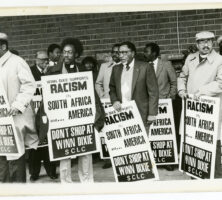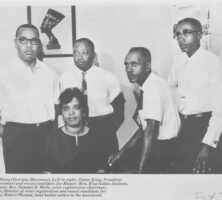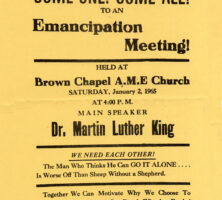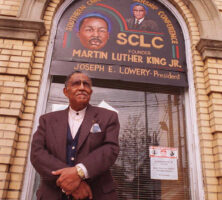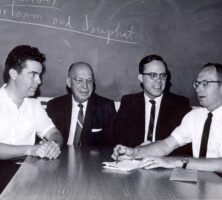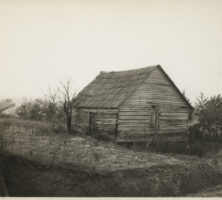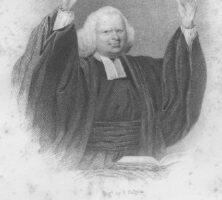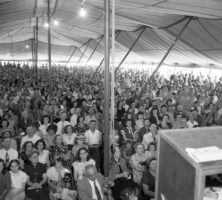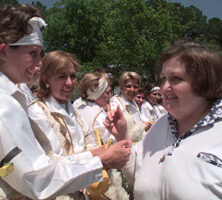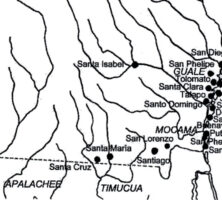The New Georgia Encyclopedia is supported by funding from A More Perfect Union, a special initiative of the National Endowment for the Humanities.
Organizers of the second Atlanta International Pop Festival initially required tickets to enter the gated festival, shown here on opening day, July 3, 1970. However, unruly crowds soon prompted the organizers to allow free entry.
Photograph by Earl McGehee
The New Georgia Encyclopedia does not hold the copyright for this media resource and can neither grant nor deny permission to republish or reproduce the image online or in print. All requests for permission to publish or reproduce the resource must be submitted to the rights holder.
The crowd at the second Atlanta International Pop Festival in Byron. Estimates vary, but the festival likely attracted between 200,000 and 300,000 people.
Courtesy of Atlanta Journal-Constitution.
The New Georgia Encyclopedia does not hold the copyright for this media resource and can neither grant nor deny permission to republish or reproduce the image online or in print. All requests for permission to publish or reproduce the resource must be submitted to the Atlanta Journal-Constitution.
Alex Cooley, pictured in 1978, owned and operated a number of the best-known rock venues in Atlanta, including Alex Cooley's Electric Ballroom and the Tabernacle. In 1987 Cooley was inducted as a nonperformer into the Georgia Music Hall of Fame.
Courtesy of Atlanta Journal-Constitution.
The New Georgia Encyclopedia does not hold the copyright for this media resource and can neither grant nor deny permission to republish or reproduce the image online or in print. All requests for permission to publish or reproduce the resource must be submitted to the Atlanta Journal-Constitution.
This homemade blacklight poster is designed after the 1970 cover of the Second Annual Atlanta International Pop Festival newspaper.
Photograph by Earl McGehee
The New Georgia Encyclopedia does not hold the copyright for this media resource and can neither grant nor deny permission to republish or reproduce the image online or in print. All requests for permission to publish or reproduce the resource must be submitted to the rights holder.
This centerfold from the second Atlanta International Pop Festival program showcases artists including Jimi Hendrix, B.B. King, and The Allman Brothers Band.
Photograph by Earl McGehee
The New Georgia Encyclopedia does not hold the copyright for this media resource and can neither grant nor deny permission to republish or reproduce the image online or in print. All requests for permission to publish or reproduce the resource must be submitted to the rights holder.
The second Atlanta International Pop Festival took place July 3-5, 1970, in Byron.
Photograph by Earl McGehee
The New Georgia Encyclopedia does not hold the copyright for this media resource and can neither grant nor deny permission to republish or reproduce the image online or in print. All requests for permission to publish or reproduce the resource must be submitted to the rights holder.
Scorching temperatures and high winds marked the second Atlanta International Pop Festival. Firetrucks were brought in to hose down attendees while medics treated sunburns.
Photograph by Earl McGehee
The New Georgia Encyclopedia does not hold the copyright for this media resource and can neither grant nor deny permission to republish or reproduce the image online or in print. All requests for permission to publish or reproduce the resource must be submitted to the rights holder.
Litter quickly covered the ground at the second Atlanta International Pop Festival in Byron.
Photograph by Earl McGehee
The New Georgia Encyclopedia does not hold the copyright for this media resource and can neither grant nor deny permission to republish or reproduce the image online or in print. All requests for permission to publish or reproduce the resource must be submitted to the rights holder.
Former members of the dissolved Ruskin Commonwealth, a utopian community in Dickson County, Tennessee, arrive at the Ware County railroad station in September 1899 to join the Duke Colony, a cooperative farming community located eight miles southwest of Waycross.
Courtesy of Georgia Archives, Vanishing Georgia, #
war002.
The New Georgia Encyclopedia does not hold the copyright for this media resource and can neither grant nor deny permission to republish or reproduce the image online or in print. Requests for permission to publish or reproduce the resource should be submitted to the Georgia Archives.
A cabin built by members of the Macedonia Cooperative Community during the 1940s is pictured in 1975. The community was founded in Habersham County in 1937 and practiced communal living, spiritual searching, and pacifism.
Photograph by W. Edward Orser
The New Georgia Encyclopedia does not hold the copyright for this media resource and can neither grant nor deny permission to republish or reproduce the image online or in print. All requests for permission to publish or reproduce the resource must be submitted to the rights holder.
The printing office for the Coming Nation, the newspaper published by the Ruskin Commonwealth in Ware County, also served as a community dining room. A cooperative farm community, the Ruskin Commonwealth was incorporated in 1899 and disbanded in 1902.
Courtesy of Georgia Archives, Vanishing Georgia, #
war014.
The New Georgia Encyclopedia does not hold the copyright for this media resource and can neither grant nor deny permission to republish or reproduce the image online or in print. Requests for permission to publish or reproduce the resource should be submitted to the Georgia Archives.
The workshop for Community Playthings, a toy and furniture business run by members of the Macedonia Cooperative Community, is pictured in 1975. The Macedonia community, located in Habersham County, was founded in 1937 and disbanded in 1957.
Photograph by W. Edward Orser
The New Georgia Encyclopedia does not hold the copyright for this media resource and can neither grant nor deny permission to republish or reproduce the image online or in print. All requests for permission to publish or reproduce the resource must be submitted to the rights holder.
This cartoon, by well-known political cartoonist Clifford "Baldy" Baldowski, refers to the Ministers' Manifesto, a statement issued by the Atlanta Christian Council in 1957 to urge the peaceful integration of public schools. A second manifesto, encouraging racial moderation, was issued in the wake of the Temple bombing in 1958. The cartoon, published in 1960, appeared in the Atlanta Constitution.
Courtesy of Richard B. Russell Library for Political Research and Studies, University of Georgia Libraries, Clifford Baldowski Editorial Cartoon Collection.
The New Georgia Encyclopedia does not hold the copyright for this media resource and can neither grant nor deny permission to republish or reproduce the image online or in print. Requests for permission to publish or reproduce the resource may need to be submitted to the Richard B. Russell Library for Political Research and Studies at the University of Georgia.
Atlanta mayor William B. Hartsfield speaks about the bombing of "the Temple" in Atlanta on October 13, 1958, the day after a dynamite blast destroyed portions of the Hebrew Benevolent Congregation's synagogue. Hartsfield denounced the act, accusing the bombers of giving "a bad name to the South."
Courtesy of Atlanta Journal-Constitution.
The New Georgia Encyclopedia does not hold the copyright for this media resource and can neither grant nor deny permission to republish or reproduce the image online or in print. All requests for permission to publish or reproduce the resource must be submitted to the Atlanta Journal-Constitution.
Reporters gather at Atlanta's city hall on August 30, 1961, the day that the city's schools were officially integrated. The recommendations of the Sibley Commission to the state legislature in 1960 contributed to the desegregation of schools across Georgia.
Courtesy of Special Collections & Archives, Georgia State University Library, Lane Brothers Commercial Photographers Photographic Collection.
The New Georgia Encyclopedia does not hold the copyright for this media resource and can neither grant nor deny permission to republish or reproduce the image online or in print. Requests for permission to publish or reproduce the resource should be submitted to Special Collections and Archives at Georgia State University.
Renowned evangelist Billy Graham, pictured in 1966, first brought his crusade to Georgia in 1948, when he visited Augusta. He returned to Georgia in 1950, drawing 25,000 people to his crusade at Ponce de Leon Ballpark in Atlanta. Later crusades in Atlanta were held in 1973 and 1994, attracting crowds of approximately 40,000 and 300,000 respectively.
Courtesy of Library of Congress, Prints and Photographs Division
The New Georgia Encyclopedia does not hold the copyright for this media resource and can neither grant nor deny permission to republish or reproduce the image online or in print. All requests for permission to publish or reproduce the resource must be submitted to the rights holder.
Billy Graham (fourth from left) attends a prayer breakfast in Atlanta with Georgia governor Jimmy Carter (second from left) in the early 1970s. State representative Dorsey Matthews stands between Carter and Graham.
Courtesy of Georgia Archives, Vanishing Georgia, #ful0088.
The New Georgia Encyclopedia does not hold the copyright for this media resource and can neither grant nor deny permission to republish or reproduce the image online or in print. Requests for permission to publish or reproduce the resource should be submitted to the Georgia Archives.
Evangelist minister Billy Graham holds a noon prayer meeting at the Peachtree Arcade in Atlanta during his six-week crusade to the city in 1950. The arcade, built in 1916-17, is an example of the Beaux-Arts style of architecture popular during the late Victorian period. It was designed by A. Ten Eyck Brown, a prominent Atlanta architect.
Courtesy of Atlanta Journal-Constitution.
The New Georgia Encyclopedia does not hold the copyright for this media resource and can neither grant nor deny permission to republish or reproduce the image online or in print. All requests for permission to publish or reproduce the resource must be submitted to the Atlanta Journal-Constitution.
Damage to the synagogue of the Hebrew Benevolent Congregation in Atlanta, known as "the Temple," is pictured on October 12, 1958, the day that fifty sticks of dynamite destroyed portions of the building, including part of the sanctuary.
Courtesy of Special Collections & Archives, Georgia State University Library, Atlanta Journal-Constitution Photographic Archive.
The New Georgia Encyclopedia does not hold the copyright for this media resource and can neither grant nor deny permission to republish or reproduce the image online or in print. Requests for permission to publish or reproduce the resource should be submitted to Special Collections and Archives at Georgia State University.
Detectives investigate the damage at the side entrance of the Hebrew Benevolent Congregation, commonly known as "the Temple," in Atlanta. The Temple was bombed on October 12, 1958, probably in response to the civil rights activism of the congregation's rabbi, Jacob Rothschild.
Courtesy of Atlanta Journal-Constitution.
The New Georgia Encyclopedia does not hold the copyright for this media resource and can neither grant nor deny permission to republish or reproduce the image online or in print. All requests for permission to publish or reproduce the resource must be submitted to the Atlanta Journal-Constitution.
Atlanta mayor William Hartsfield (left) and Jacob Rothschild, rabbi of the Hebrew Benevolent Congregation in Atlanta, examine rubble on October 13, 1958, the day after the bombing of the congregation's synagogue, known as "the Temple."
Courtesy of Atlanta Journal-Constitution.
The New Georgia Encyclopedia does not hold the copyright for this media resource and can neither grant nor deny permission to republish or reproduce the image online or in print. All requests for permission to publish or reproduce the resource must be submitted to the Atlanta Journal-Constitution.
Atlanta police officials W. K. Perry (left) and I. G. Cowan investigate the synagogue of the Hebrew Benevolent Congregation in Atlanta, which was dynamited on October 12, 1958. The involvement of the Temple's rabbi, Jacob Rothschild, in the civil rights movement may have been the motivation behind the bombing.
Courtesy of Atlanta Journal-Constitution.
The New Georgia Encyclopedia does not hold the copyright for this media resource and can neither grant nor deny permission to republish or reproduce the image online or in print. All requests for permission to publish or reproduce the resource must be submitted to the Atlanta Journal-Constitution.
Observers investigate damage to "the Temple," the synagogue of the Hebrew Benevolent Congregation in Atlanta, on October 13, 1958, the day after the building was bombed. Although no one was injured in the blast, damage amounted to $100,000.
Courtesy of Atlanta Journal-Constitution.
The New Georgia Encyclopedia does not hold the copyright for this media resource and can neither grant nor deny permission to republish or reproduce the image online or in print. All requests for permission to publish or reproduce the resource must be submitted to the Atlanta Journal-Constitution.
George Bright (left), a suspect in the bombing of the Hebrew Benevolent Congregation's synagogue in Atlanta, stands with his attorney, Reuben Garland, during his January 1959 trial. Much to the dismay of Atlanta's Jewish community, Garland won an acquittal for Bright, the only suspect ever brought to trial.
Courtesy of Atlanta Journal-Constitution.
The New Georgia Encyclopedia does not hold the copyright for this media resource and can neither grant nor deny permission to republish or reproduce the image online or in print. All requests for permission to publish or reproduce the resource must be submitted to the Atlanta Journal-Constitution.
The Hebrew Benevolent Congregation, which first organized in 1860 as the Hebrew Benevolent Society, began construction in 1875 on a synagogue in Atlanta. The Temple, as it came to be known, continues to serve the Jewish community in the city.
Photograph by David
The New Georgia Encyclopedia does not hold the copyright for this media resource and can neither grant nor deny permission to republish or reproduce the image online or in print. All requests for permission to publish or reproduce the resource must be submitted to the rights holder.
German artist Philip Georg Friedrich von Reck drew a map of New Ebenezer during his visit to the settlement in 1736. New Ebenezer, located on the bluffs above the Savannah River, was the second settlement established by the Georgia Salzburgers, a group of Protestants expelled from the Catholic province of Salzburg in 1731.
Illustration by Philip Georg Friedrich von Reck
The New Georgia Encyclopedia does not hold the copyright for this media resource and can neither grant nor deny permission to republish or reproduce the image online or in print. All requests for permission to publish or reproduce the resource must be submitted to the rights holder.
Jerusalem Church was established by the Salzburgers in Ebenezer during the 1730s. Ebenezer, left in ruins after the Revolutionary War, had disappeared by 1855, but Jerusalem Church, now known as Jerusalem Evangelical Lutheran Church, still stands. It is one of the few buildings in Georgia left intact after the Revolutionary War.
Photograph by Bruce Tuten
The New Georgia Encyclopedia does not hold the copyright for this media resource and can neither grant nor deny permission to republish or reproduce the image online or in print. All requests for permission to publish or reproduce the resource must be submitted to the rights holder.
This sketch of the early Ebenezer settlement was drawn in 1736 by Philip Georg Friedrich von Reck. That same year the Salzburger settlement moved to a location closer to the Savannah River, where conditions were better for farming.
Print from Von Reck Archive, Royal Library of Denmark, Copenhagen
The New Georgia Encyclopedia does not hold the copyright for this media resource and can neither grant nor deny permission to republish or reproduce the image online or in print. All requests for permission to publish or reproduce the resource must be submitted to the rights holder.
The ritual of snake handling, practiced mainly by Pentecostal congregations, began in East Tennessee during the early 1900s and spread into Georgia's Berrien and Cook counties by 1920. Today congregations in Kingston and Cartersville are the most well known practitioners in the state.
Courtesy of Atlanta Journal-Constitution.
The New Georgia Encyclopedia does not hold the copyright for this media resource and can neither grant nor deny permission to republish or reproduce the image online or in print. All requests for permission to publish or reproduce the resource must be submitted to the Atlanta Journal-Constitution.
The headquarters for the Cooperative Baptist Fellowship of Georgia are located in Macon. The national fellowship, founded in Atlanta in 1991, was formed as an alternative to the more fundmentalist doctrine of the Southern Baptist Convention.
Courtesy of Cooperative Baptist Fellowship of Georgia
The New Georgia Encyclopedia does not hold the copyright for this media resource and can neither grant nor deny permission to republish or reproduce the image online or in print. All requests for permission to publish or reproduce the resource must be submitted to the rights holder.
Daniel Vestal served as chair of the steering committee that resulted in the founding of the Cooperative Baptist Fellowship in 1991. A native of Texas, Vestal was a minister at the Dunwoody Baptist Church in Atlanta at the time of the fellowship's inception.
Courtesy of Cooperative Baptist Fellowship of Georgia
The New Georgia Encyclopedia does not hold the copyright for this media resource and can neither grant nor deny permission to republish or reproduce the image online or in print. All requests for permission to publish or reproduce the resource must be submitted to the rights holder.
Volunteers paint a Georgia home during the March Mission Madness program sponsored by the Cooperative Baptist Fellowship. In addition to supporting mission work, the fellowship operates several summer camps and publishes a newsletter.
Courtesy of Cooperative Baptist Fellowship of Georgia
The New Georgia Encyclopedia does not hold the copyright for this media resource and can neither grant nor deny permission to republish or reproduce the image online or in print. All requests for permission to publish or reproduce the resource must be submitted to the rights holder.
First Christian Church of Dublin is one of nearly seventy Christian Church (Disciples of Christ) congregations in Georgia. This Protestant group was founded in 1832 by the union of the "Christians" in Kentucky and the "Disciples of Christ" in Pennsylvania.
Courtesy of Christian Church (Disciples of Christ) in Georgia
The New Georgia Encyclopedia does not hold the copyright for this media resource and can neither grant nor deny permission to republish or reproduce the image online or in print. All requests for permission to publish or reproduce the resource must be submitted to the rights holder.
The New Georgia Encyclopedia does not hold the copyright for this media resource and can neither grant nor deny permission to republish or reproduce the image online or in print. All requests for permission to publish or reproduce the resource must be submitted to the rights holder.
In 1809 Alexander Campbell arrived in Pennsylvania from Scotland to join his father, Thomas Campbell, a Presbyterian minister who organized the Disciples of Christ in 1807. The Campbells' group united with the "Christians" of Kentucky in 1832, becoming the Christian Church (Disciples of Christ). Today around seventy congregations of this fellowship exist in Georgia.
Courtesy of Library of Congress, Prints and Photographs division
The New Georgia Encyclopedia does not hold the copyright for this media resource and can neither grant nor deny permission to republish or reproduce the image online or in print. All requests for permission to publish or reproduce the resource must be submitted to the rights holder.
The New Georgia Encyclopedia does not hold the copyright for this media resource and can neither grant nor deny permission to republish or reproduce the image online or in print. All requests for permission to publish or reproduce the resource must be submitted to the rights holder.
John Wesley, the founder of Methodism, traveled with his brother Charles from England to the Georgia colony in 1736. During their passage, the brothers befriended a group of Moravian missionaries, who would prove to have a significant theological influence on Wesley.
The New Georgia Encyclopedia does not hold the copyright for this media resource and can neither grant nor deny permission to republish or reproduce the image online or in print. For more information about this resource, contact the Stuart A. Rose Manuscript, Archives, and Rare Book Library at Emory University.
The home of Cherokee chief James Vann was located north of the Moravian Mission at Spring Place. Invited by Vann and other Cherokee leaders, the Moravians provided a school for Cherokee children and housed 114 students between 1804 and 1833.
The New Georgia Encyclopedia does not hold the copyright for this media resource and can neither grant nor deny permission to republish or reproduce the image online or in print. Requests for permission to publish or reproduce the resource should be submitted to the Hargrett Manuscript and Rare Book Library at the University of Georgia.
The New Georgia Encyclopedia does not hold the copyright for this media resource and can neither grant nor deny permission to republish or reproduce the image online or in print. All requests for permission to publish or reproduce the resource must be submitted to the rights holder.
Count Nicolaus Ludwig von Zinzendorf helped to lead the Moravian missionary efforts in Georgia from 1735 to 1745. The Moravian settlers, part of a Protestant sect founded in the fifteenth century in the present-day Czech Republic, settled in Savannah during their time in Georgia.
The New Georgia Encyclopedia does not hold the copyright for this media resource and can neither grant nor deny permission to republish or reproduce the image online or in print. Requests for permission to publish or reproduce the resource should be submitted to the Hargrett Manuscript and Rare Book Library at the University of Georgia.
Several varieties of corn, including flour, flint, dent, pop, and sweet, are grown in Georgia during the summer months. Although the pop and sweet varieties are produced for human consumption, most of the corn raised in Georgia is used for animal feed.
Courtesy of Dewey Lee
The New Georgia Encyclopedia does not hold the copyright for this media resource and can neither grant nor deny permission to republish or reproduce the image online or in print. All requests for permission to publish or reproduce the resource must be submitted to the rights holder.
The women of Columbus, led by Lizzie Rutherford, began to maintain the Confederate section of Linwood Cemetery shortly before the Civil War ended. Rutherford's efforts were among the earliest to foster a nostalgia for the prewar South that eventually culminated in what historians today term "Lost Cause religion."
Courtesy of Historic Linwood Foundation, Inc.
The New Georgia Encyclopedia does not hold the copyright for this media resource and can neither grant nor deny permission to republish or reproduce the image online or in print. All requests for permission to publish or reproduce the resource must be submitted to the rights holder.
A proponent of the Lost Cause ideology, Clement Evans was a Civil War veteran, minister, student of military history, and cofounder of the United Confederate Veterans.
Courtesy of Hargrett Rare Book and Manuscript Library, University of Georgia Libraries, Georgia Photo File.
The New Georgia Encyclopedia does not hold the copyright for this media resource and can neither grant nor deny permission to republish or reproduce the image online or in print. Requests for permission to publish or reproduce the resource should be submitted to the Hargrett Manuscript and Rare Book Library at the University of Georgia.
The New Georgia Encyclopedia does not hold the copyright for this media resource and can neither grant nor deny permission to republish or reproduce the image online or in print. All requests for permission to publish or reproduce the resource must be submitted to the rights holder.
Mildred Lewis Rutherford, a teacher, historian, writer, and lecturer known primarily for her Confederate memorial activities, published a monthy periodical entitled Miss Rutherford's Scrap Book from 1923 to 1926.
From Miss Rutherford's Scrap Book, vol. 4, April 1923
The New Georgia Encyclopedia does not hold the copyright for this media resource and can neither grant nor deny permission to republish or reproduce the image online or in print. All requests for permission to publish or reproduce the resource must be submitted to the rights holder.
The carving on Stone Mountain depicts the Confederate icons Robert E. Lee, Thomas "Stonewall" Jackson, and Jefferson Davis. Commissioned by the president of the United Daughters of the Confederacy, the sculptor Gutzon Borglum began work on the relief in 1915. He was fired in 1925, and Augustus Lukeman completed the carving.
Photograph by Mark Griffin, Wikimedia
The New Georgia Encyclopedia does not hold the copyright for this media resource and can neither grant nor deny permission to republish or reproduce the image online or in print. All requests for permission to publish or reproduce the resource must be submitted to the rights holder.
The Augusta Confederate Monument in downtown Augusta bears an inscription that encapsulates the sentiments of the Lost Cause: "No Nation Rose So White and Fair; None Fell So Pure of Crime."
Photograph by Elisabeth Hughes, New Georgia Encyclopedia
The New Georgia Encyclopedia does not hold the copyright for this media resource and can neither grant nor deny permission to republish or reproduce the image online or in print. All requests for permission to publish or reproduce the resource must be submitted to the rights holder.
Clarence Jordan, the cofounder of Koinonia Farm, poses with the children of community members. By 1956, the population of the farm had grown to around sixty people, but by the end of the 1960s only two families remained.
Courtesy of Hargrett Rare Book and Manuscript Library, University of Georgia Libraries, Clarence Jordan Papers.
The New Georgia Encyclopedia does not hold the copyright for this media resource and can neither grant nor deny permission to republish or reproduce the image online or in print. Requests for permission to publish or reproduce the resource should be submitted to the Hargrett Manuscript and Rare Book Library at the University of Georgia.
Koinonia Farm, founded in 1942 by Clarence Jordan and Martin England, began as an experiment to establish a racially integrated Christian community and working communal farm. This aerial view of the farm was taken in 1953.
Courtesy of Hargrett Rare Book and Manuscript Library, University of Georgia Libraries, Clarence Jordan Papers.
The New Georgia Encyclopedia does not hold the copyright for this media resource and can neither grant nor deny permission to republish or reproduce the image online or in print. Requests for permission to publish or reproduce the resource should be submitted to the Hargrett Manuscript and Rare Book Library at the University of Georgia.
Clarence Jordan feeds poultry in the chicken house at Koinonia Farm. During the difficult years of the 1950s, the residents of Koinonia Farm established a mail-order pecan business to keep the farm afloat, selling pecans to sympathetic customers around the country.
Courtesy of Hargrett Rare Book and Manuscript Library, University of Georgia Libraries, Clarence Jordan Papers.
The New Georgia Encyclopedia does not hold the copyright for this media resource and can neither grant nor deny permission to republish or reproduce the image online or in print. Requests for permission to publish or reproduce the resource should be submitted to the Hargrett Manuscript and Rare Book Library at the University of Georgia.
Clarence Jordan works in the fields of Koinonia Farm. By 1969 the farm had expanded to more than 1,400 acres, and Jordan, along with new partner Millard Fuller, began to construct low-cost housing on the land. The Koinonia housing villages were the precursor to Habitat for Humanity, which Fuller left the farm to establish in 1976.
Courtesy of Hargrett Rare Book and Manuscript Library, University of Georgia Libraries, Clarence Jordan Papers.
The New Georgia Encyclopedia does not hold the copyright for this media resource and can neither grant nor deny permission to republish or reproduce the image online or in print. Requests for permission to publish or reproduce the resource should be submitted to the Hargrett Manuscript and Rare Book Library at the University of Georgia.
Koinonia Farm, founded in rural Sumter County in 1942, continues to operate a mail-order business and to promote the principles of peace and racial reconciliation upon which it was founded.
Courtesy of Hargrett Rare Book and Manuscript Library, University of Georgia Libraries, Koinonia Farm Photographs.
The New Georgia Encyclopedia does not hold the copyright for this media resource and can neither grant nor deny permission to republish or reproduce the image online or in print. Requests for permission to publish or reproduce the resource should be submitted to the Hargrett Manuscript and Rare Book Library at the University of Georgia.
Jubilee Partners is located on 260 acres of meadow and forest land two hours east of Atlanta in rural northeast Georgia. The central goal at Jubilee Partners is to make the biblical vison of "jubilee" a reality in people's lives.
Photograph by Chad A.S. Mullikin
The New Georgia Encyclopedia does not hold the copyright for this media resource and can neither grant nor deny permission to republish or reproduce the image online or in print. All requests for permission to publish or reproduce the resource must be submitted to the rights holder.
Jubilee Partners, together with refugees, celebrated the largest Thanksgiving in its history in 2004. The first fourteen refugees arrived from Cuba in 1980 and have been followed by many more from war-torn countries in Central America, the former Yugoslavia, the Middle East, and Africa.
Courtesy of Jubilee Partners
The New Georgia Encyclopedia does not hold the copyright for this media resource and can neither grant nor deny permission to republish or reproduce the image online or in print. All requests for permission to publish or reproduce the resource must be submitted to the rights holder.
Artwork by children and adult refugees hangs on the wall in the Jubilee Partners school, which is used primarily to teach English as a second language. The art depicts a variety of topics, including landscapes from the refugees' native countries.
Photograph by Melinda S. Mullikin, New Georgia Encyclopedia
The New Georgia Encyclopedia does not hold the copyright for this media resource and can neither grant nor deny permission to republish or reproduce the image online or in print. All requests for permission to publish or reproduce the resource must be submitted to the rights holder.
Ralph David Abernathy (second from left) marches with Coretta Scott King and Martin Luther King Jr. (center) in 1966 on the Georgia state capitol. All were influential leaders during the early years of the Southern Christian Leadership Conference.
Courtesy of Atlanta Journal-Constitution.
The New Georgia Encyclopedia does not hold the copyright for this media resource and can neither grant nor deny permission to republish or reproduce the image online or in print. All requests for permission to publish or reproduce the resource must be submitted to the Atlanta Journal-Constitution.
The Reverend Joseph Lowery (middle, right), the Reverend Randel Osburn (middle, left), and others picket a Winn-Dixie grocery store in Atlanta. The Southern Christian Leadership Conference's boycott of Winn-Dixie began in the fall of 1985 and lasted four months, ending only when the chain agreed to stop selling products grown or manufactured in South Africa.
Courtesy of Stuart A. Rose Manuscript, Archives, and Rare Book Library, Emory University, Southern Christian Leadership Conference Records, Photograph by Elaine Tomlin.
The New Georgia Encyclopedia does not hold the copyright for this media resource and can neither grant nor deny permission to republish or reproduce the image online or in print. For more information about this resource, contact the Stuart A. Rose Manuscript, Archives, and Rare Book Library at Emory University.
Martin Luther King Jr., Baptist minister and president of the Southern Christian Leadership Conference, was the most prominent African American leader in the civil rights movement of the 1950s and 1960s. He was assassinated on April 4, 1968, in Memphis, Tennessee.
The New Georgia Encyclopedia does not hold the copyright for this media resource and can neither grant nor deny permission to republish or reproduce the image online or in print. Requests for permission to publish or reproduce the resource should be submitted to the Hargrett Manuscript and Rare Book Library at the University of Georgia.
The Albany Movement leaders included, from left, Slater King, the president of the movement; Elza Goldie Jackson, the recording secretary; the Reverend Sammie B. Wells, the chairman of voter registration; Thomas Chatmon, the director of voter registration; and Robert Thomas, a local barber and active volunteer.
Reprinted from Freedomways
The New Georgia Encyclopedia does not hold the copyright for this media resource and can neither grant nor deny permission to republish or reproduce the image online or in print. All requests for permission to publish or reproduce the resource must be submitted to the rights holder.
This flyer advertises an "emancipation meeting" cosponsored by the SCLC and featuring Martin Luther King Jr. as the speaker. The SCLC organized "right-to-vote" marches and registration drives in Georgia during the 1960s.
The New Georgia Encyclopedia does not hold the copyright for this media resource and can neither grant nor deny permission to republish or reproduce the image online or in print. All requests for permission to publish or reproduce the resource must be submitted to the rights holder.
Joseph Lowery stands before the SCLC headquarters in Atlanta. In 1977 Lowery succeeded Ralph David Abernathy as president of the SCLC, which has been based in Atlanta since its inception in 1957.
Courtesy of Atlanta Journal-Constitution.
The New Georgia Encyclopedia does not hold the copyright for this media resource and can neither grant nor deny permission to republish or reproduce the image online or in print. All requests for permission to publish or reproduce the resource must be submitted to the Atlanta Journal-Constitution.
A popular debate over whether "God is dead" was occasioned by the so-called radical theology propounded in the 1960s by Thomas J. J. Altizer (far left), then a professor of religion at Emory University in Atlanta. Emory religion professors E. H. Reece (next to Altizer) and Jack Boozer (far right) also pictured.
The New Georgia Encyclopedia does not hold the copyright for this media resource and can neither grant nor deny permission to republish or reproduce the image online or in print. All requests for permission to publish or reproduce the resource must be submitted to the rights holder.
The New Georgia Encyclopedia does not hold the copyright for this media resource and can neither grant nor deny permission to republish or reproduce the image online or in print. All requests for permission to publish or reproduce the resource must be submitted to the rights holder.
The Taloney Mission (later Carmel Mission) was founded by the Georgia Presbyterians in Pickens County along Talking Rock Creek. The Presbyterians established and ran a number of mission schools throughout Georgia from 1817 to 1833. The remains of the Taloney Mission were photographed between 1930 and 1960.
The New Georgia Encyclopedia does not hold the copyright for this media resource and can neither grant nor deny permission to republish or reproduce the image online or in print. Requests for permission to publish or reproduce the resource should be submitted to the Hargrett Manuscript and Rare Book Library at the University of Georgia.
George Whitefield, an Anglican minister, was the central figure of the Great Awakening, which occurred from about 1720 to 1780 in America. The series of revivals sparked a move away from formal, outward religion to inward, personal religion.
The New Georgia Encyclopedia does not hold the copyright for this media resource and can neither grant nor deny permission to republish or reproduce the image online or in print. All requests for permission to publish or reproduce the resource must be submitted to the rights holder.
Early revival preachers practiced a riveting preaching style: they spoke extemporaneously rather than reading from prepared sermons; spoke to, not at, their listeners; and used pamphlets and newspapers to promote sermons. While the camp meeting tradition has changed, many of the early revivalist techniques still thrive today.
Courtesy of Special Collections & Archives, Georgia State University Library, Lane Brothers Commercial Photographers Photographic Collection.
The New Georgia Encyclopedia does not hold the copyright for this media resource and can neither grant nor deny permission to republish or reproduce the image online or in print. Requests for permission to publish or reproduce the resource should be submitted to Special Collections and Archives at Georgia State University.
The New Georgia Encyclopedia does not hold the copyright for this media resource and can neither grant nor deny permission to republish or reproduce the image online or in print. All requests for permission to publish or reproduce the resource must be submitted to the rights holder.
The New Georgia Encyclopedia does not hold the copyright for this media resource and can neither grant nor deny permission to republish or reproduce the image online or in print. All requests for permission to publish or reproduce the resource must be submitted to the rights holder.
During the 1990s Nancy Fowler (right), of Conyers, claimed that the Virgin Mary appeared to her and asked her to take messages to the public.
Courtesy of Atlanta Journal-Constitution.
The New Georgia Encyclopedia does not hold the copyright for this media resource and can neither grant nor deny permission to republish or reproduce the image online or in print. All requests for permission to publish or reproduce the resource must be submitted to the Atlanta Journal-Constitution.
The New Georgia Encyclopedia does not hold the copyright for this media resource and can neither grant nor deny permission to republish or reproduce the image online or in print. All requests for permission to publish or reproduce the resource must be submitted to the rights holder.
The New Georgia Encyclopedia does not hold the copyright for this media resource and can neither grant nor deny permission to republish or reproduce the image online or in print. All requests for permission to publish or reproduce the resource must be submitted to the rights holder.
Courtesy of John Worth
The New Georgia Encyclopedia does not hold the copyright for this media resource and can neither grant nor deny permission to republish or reproduce the image online or in print. All requests for permission to publish or reproduce the resource must be submitted to the rights holder.
